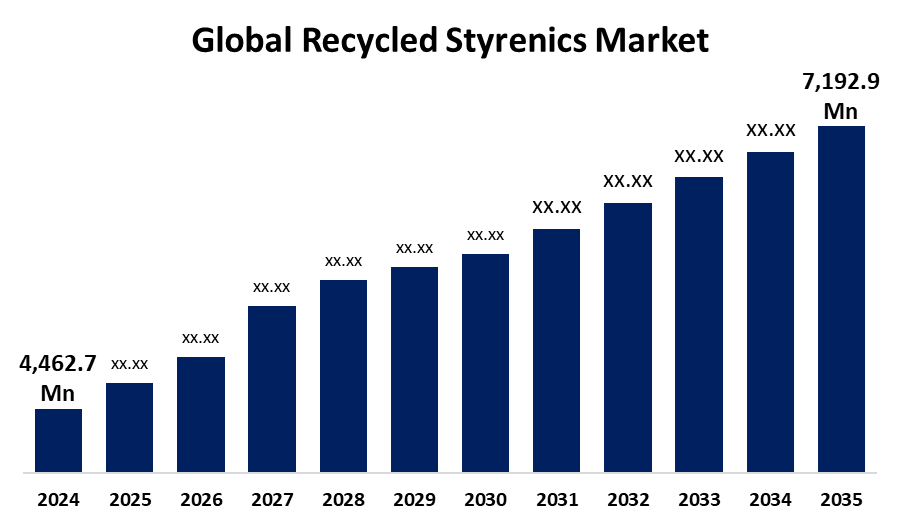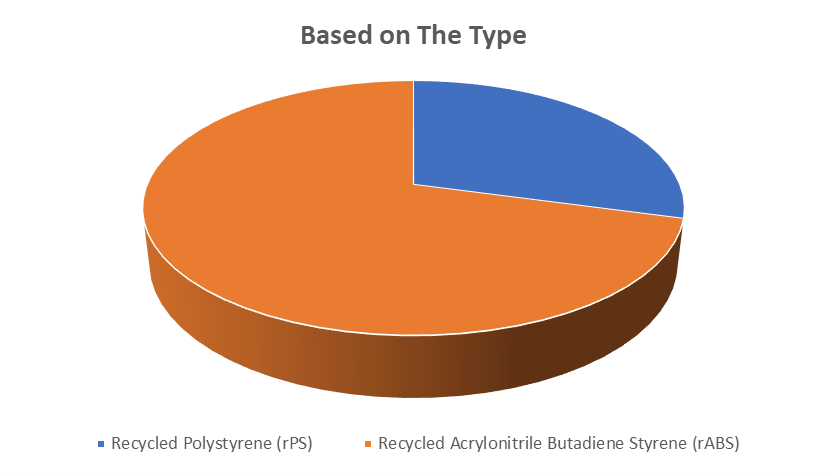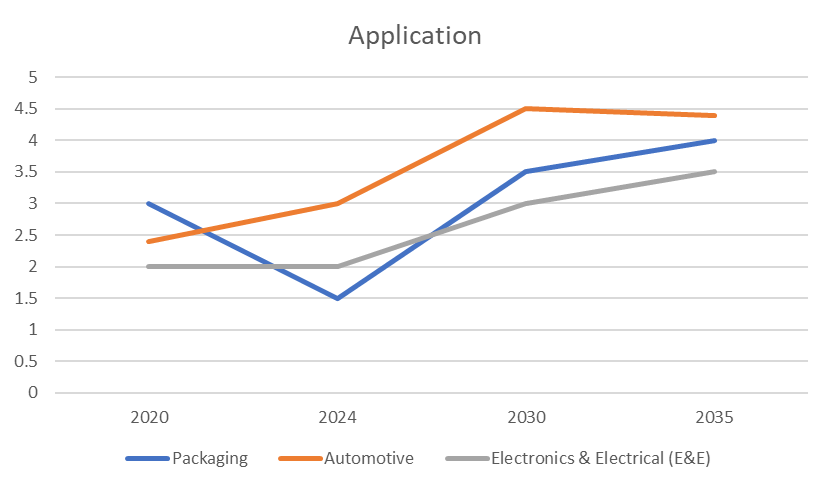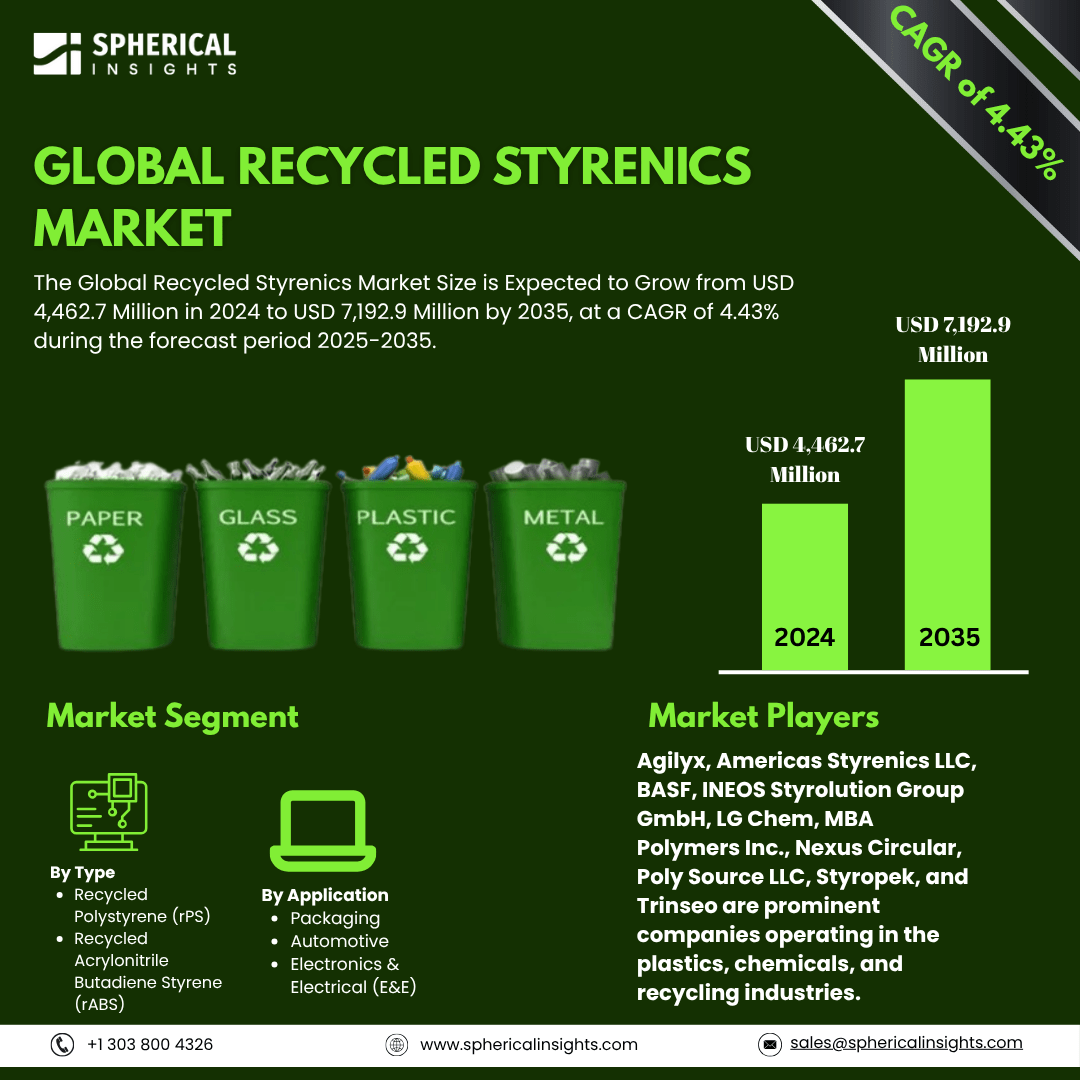Global Recycled Styrenics Market Insights Forecasts to 2035
- The Global Recycled Styrenics Market Size Was Estimated at USD 4,462.7 Million in 2024
- The Market Size is Expected to Grow at a CAGR of around 4.43% from 2025 to 2035
- The Worldwide Recycled Styrenics Market Size is Expected to Reach USD 7,192.9 Million by 2035
- North America is Expected to Grow the fastest during the forecast period.

Recycled Styrenics Market
The global recycled styrenics market focuses on the recovery and reuse of styrenic polymers, particularly polystyrene (PS) and its copolymers, to create new products. This market is growing as industries increasingly adopt sustainable practices to reduce plastic waste. Recycled styrenics are used across various applications, such as packaging, automotive, consumer goods, and electronics, due to their versatility and cost-effectiveness. The process involves collecting post-consumer or post-industrial styrenic waste, which is then purified and reprocessed into reusable material. Recycled styrenics offer environmental benefits, including lower resource consumption and reduced pollution compared to virgin materials. The market is also witnessing innovations in recycling technologies, which improve the quality and efficiency of the recycling process. As regulations around plastic waste tighten and consumer demand for eco-friendly products rises, the use of recycled styrenics continues to expand, aligning with global shifts toward sustainability and circular economy practices.
Attractive Opportunities in the Recycled Styrenics Market
- Chemical recycling and other advanced methods are improving the quality of recycled styrenics, making them more competitive with virgin materials. Innovation in recycling processes opens doors to cost-effective, high-quality solutions across industries.
- With growing regulatory pressures and consumer demand for eco-friendly products, the shift toward a circular economy is creating strong demand for recycled styrenics, especially in packaging and automotive sectors, where recyclability and sustainability are key focus areas.
Global Recycled Styrenics Market Dynamics
DRIVER: Increasing environmental awareness
Increasing environmental awareness and the push for sustainable practices are compelling industries to shift towards recycled materials, including styrenics. Governments worldwide are implementing stricter regulations on plastic waste, such as extended producer responsibility (EPR) laws, incentivizing companies to adopt recycling solutions. Additionally, the growing demand for eco-friendly packaging solutions in sectors like food, retail, and electronics is boosting the consumption of recycled styrenics. Advancements in recycling technologies, including chemical recycling methods, have improved the efficiency and quality of recycled styrenics, making them more competitive with virgin materials. Moreover, the rising cost of raw materials and energy has made recycled styrenics more attractive as a cost-effective alternative. Lastly, the increasing focus on a circular economy, which promotes reusing and recycling materials, is encouraging industries to adopt recycled styrenics as part of their sustainability strategies.
RESTRAINT: Recycling process itself is resource-intensive and requires advanced technologies
One significant challenge is the variability in the quality and purity of recycled styrenic materials. Contaminants from mixed waste streams or poor sorting during collection can affect the final product, making it less reliable compared to virgin styrenics. Moreover, the recycling process itself is resource-intensive and requires advanced technologies, which are not yet widely available in all regions. This creates a gap in accessibility, particularly in developing economies. The capital investment needed to establish specialized recycling plants also remains a deterrent for smaller companies. Another issue is the limited demand for recycled styrenics in certain applications, as some industries still prioritize the use of virgin materials due to concerns over performance and cost. Furthermore, competition from other types of recycled plastics, such as polyethylene or polypropylene, which are easier to process, adds another layer of complexity for the recycled styrenics sector.
OPPORTUNITY: Integration of recycled styrenics into emerging sectors like 3D printing
One key prospect lies in the integration of recycled styrenics into emerging sectors like 3D printing, where sustainable materials are increasingly sought after for prototyping and production. As the demand for environmentally responsible manufacturing rises, the use of recycled styrenics in specialized applications, such as custom packaging or medical devices, could become more prominent. Another opportunity is the collaboration between brands and research institutions to create advanced recycling methods, which could make styrenics recycling more efficient and cost-effective. There's also a growing potential for recycled styrenics in the production of durable consumer goods, such as furniture or home decor, where aesthetic appeal and sustainability are equally valued. Additionally, as sustainability initiatives gain momentum, new business models based on product stewardship or take-back schemes could create a steady supply of post-consumer styrenic waste, fueling market growth and innovation.
CHALLENGES: Lack of standardization in the certification of recycled styrenics
Disjointed collection and sorting systems in various regions create inefficiencies, leading to inconsistent material availability and higher costs. Additionally, there is a lack of standardization in the certification of recycled styrenics, making it difficult for manufacturers to confidently integrate them into their production lines. Another challenge is the technical difficulty in achieving high-quality recycled styrenic products, particularly when compared to the performance of virgin styrenics. Recycled materials often have limited aesthetic qualities, which can deter their use in design-sensitive applications like consumer electronics or packaging. The market also struggles with scaling recycling processes to meet the growing demand, as existing facilities are often underfunded or outdated. Finally, economic factors, such as fluctuations in oil prices, can disrupt the cost-effectiveness of recycling, further complicating market expansion efforts.
Global Recycled Styrenics Market Ecosystem Analysis
The global recycled styrenics market ecosystem involves key players across various stages, including waste collectors, recycling technology providers, manufacturers, brand owners, and consumers. Raw materials are sourced from post-consumer waste, processed using mechanical or chemical recycling technologies, and then transformed into new products across sectors like packaging, automotive, and electronics. Regulatory bodies, NGOs, and financial institutions drive sustainability efforts, influencing market demand and technological advancements. This interconnected ecosystem relies on collaboration to increase recycling efficiency, improve material quality, and meet sustainability goals, fostering a circular economy for styrenics.
Based on the type, the recycled acrylonitrile butadiene styrene (rABS) segment dominated the recycled styrenics market and is expected to grow at a significant CAGR over the forecast period

rABS is highly valued for its excellent balance of strength, impact resistance, and heat resistance, making it a preferred material in industries such as automotive, electronics, and consumer goods. Its ability to be effectively recycled and reused enhances its appeal, particularly as sustainability initiatives gain momentum. As more industries adopt eco-friendly practices and seek alternatives to virgin materials, the demand for rABS is expected to rise, bolstering its growth. Moreover, technological advancements in recycling processes are improving the quality of rABS, further expanding its potential in various high-performance applications.
Based on the application, the automotive segment is projected to witness a rapid CAGR during the forecast period

The segment growth is primarily driven by the increasing adoption of sustainable materials in automotive manufacturing as part of efforts to reduce carbon footprints and enhance fuel efficiency. Recycled styrenics, including materials like recycled acrylonitrile butadiene styrene (rABS), offer excellent properties such as durability, impact resistance, and lightweight characteristics, making them ideal for automotive applications like interior components, dashboards, and exterior body panels. Additionally, stringent environmental regulations and the rising consumer demand for eco-friendly vehicles are pushing automotive manufacturers to integrate more recycled materials. With advancements in recycling technologies that improve material quality and performance, the automotive sector is expected to significantly contribute to the overall growth of the recycled styrenics market.
Asia Pacific is anticipated to hold the largest share of the recycled styrenics market during the forecast period
Asia Pacific is expected to hold the largest share of the global recycled styrenics market during the forecast period. This can be attributed to the region's significant manufacturing base, particularly in industries like packaging, automotive, and electronics, which are key consumers of recycled styrenic materials. Countries such as China, Japan, and South Korea are investing heavily in recycling infrastructure and sustainable practices, driven by both regulatory pressure and rising environmental awareness. Additionally, Asia Pacific benefits from a large volume of post-consumer plastic waste, providing a steady supply of recyclable styrenic materials. The region is also home to numerous companies developing and implementing advanced recycling technologies, further boosting the market's growth. With increasing demand for eco-friendly products and a growing emphasis on circular economy practices, Asia Pacific is poised to lead the market in both volume and value during the forecast period.
North America is expected to grow at the fastest CAGR in the recycled styrenics market during the forecast period
The regional growth is driven by a strong regulatory push toward sustainability, including stringent recycling mandates and extended producer responsibility (EPR) laws across the United States and Canada. Additionally, the growing demand for eco-friendly materials in key sectors like automotive, packaging, and electronics is spurring the adoption of recycled styrenics. North America also benefits from advanced recycling technologies, which improve the quality and cost-effectiveness of recycled styrenic products. Increased investment in recycling infrastructure and the rising focus on circular economy initiatives are further fueling market expansion. With increasing consumer preference for sustainable products and a robust manufacturing landscape, North America is poised for rapid growth in the recycled styrenics market.
Recent Development
- In April 2023, Styrolution announced an advancement in its chemical recycling technology, focusing on the pyrolysis process to recover high-quality styrene monomers from mixed plastic waste. This development aims to make recycled styrenics comparable in quality to virgin materials.
Key Market Players
KEY PLAYERS IN THE RECYCLED STYRENICS MARKET INCLUDE
This study forecasts revenue at global, regional, and country levels from 2020 to 2035. Spherical Insights has segmented the recycled styrenics market based on the below-mentioned segments:






